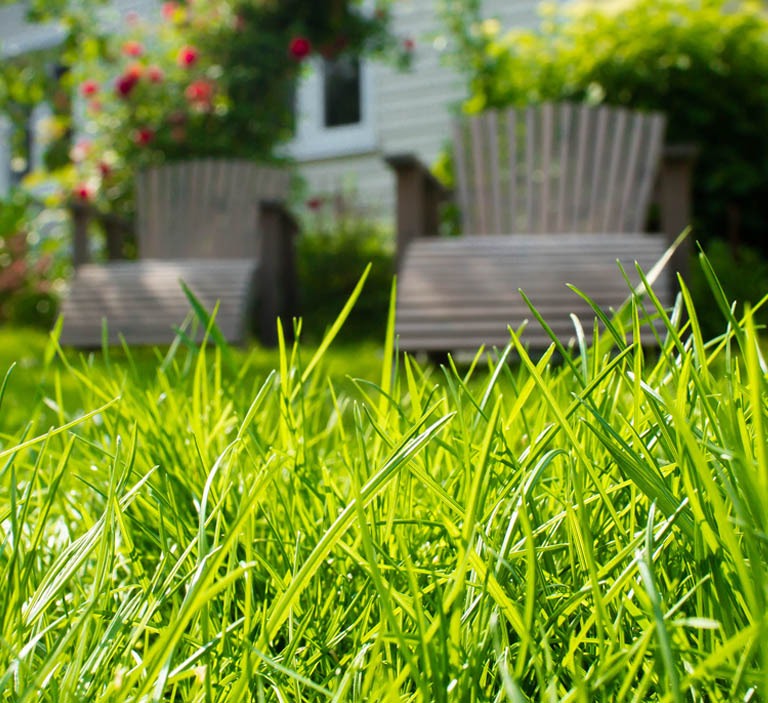One of the most frustrating aspects of taking care of your lawn and landscaping is noticing how quickly weeds can pop up, leaving you feeling defeated. We’re here to help you keep your green spaces weed-free year-round.
Effective weed control is essential to maintaining a healthy, lush lawn. Weeds can quickly take over your yard, detracting from your property’s curb appeal and choking out desirable plants. One of the most common debates among homeowners and lawn care professionals is whether to combat weeds by using pre-emergent or post-emergent herbicides. Let’s break down the differences between these two types of weed control to give you a clear understanding of which method—or combination of methods—will work best for your lawn.
What is Pre-Emergent Weed Control?
Pre-emergent weed control is all about prevention, focusing on stopping weeds before they even start to grow. These herbicides create a chemical barrier in the soil that prevents weed seeds from germinating and taking root, effectively nipping the problem in the bud before it even starts.
How Pre-Emergent Herbicides Work
Pre-emergent herbicides work by forming a protective layer on the soil surface. When the weed seeds begin to germinate, they absorb the herbicide, disrupting their growth process and preventing them from establishing a root system.
Types of Pre-Emergent Herbicides
Various pre-emergent herbicides are available on the market, ranging from synthetic to organic options. Some of the most popular types include:
- Prodiamine: Effective and long-lasting, this is commonly used for crabgrass prevention.
- Dithiopyr: This is a popular choice for its ability to control broadleaf weeds and grassy weeds.
Application Timing and Techniques
Timing is everything when applying pre-emergent herbicides. For spring-germinating weeds, such as crabgrass, it’s best to apply pre-emergent herbicides in early spring, before soil temperatures reach 55°F. For weeds that germinate in the fall, such as annual bluegrass, an early fall application is recommended. Pre-emergent herbicides can be applied using a broadcast spreader for granular products or a sprayer for liquid formulations.
Pros and Cons of Pre-Emergent Weed Control
Pros:
- Prevents weeds from taking root, reducing the need for post-emergent treatments
- Helps maintain a weed-free lawn throughout the growing season, reducing the need for manual weeding or additional treatments.
- Long-lasting protection when applied correctly.
Cons:
- Timing is key. If applied too late, the weeds may have already sprouted and the treatment will not be effective.
- It does not kill existing weeds, so it must be used with other methods if weeds are already present.
- It can affect the germination of desirable plants if not applied carefully.
- Some products may require professional application to ensure proper coverage.
What is Post-Emergent Weed Control?
Post-emergent weed control is used to tackle weeds that have already sprouted and are actively growing in your lawn. These herbicides target the weed’s foliage, disrupting their growth processes and leading to the weed’s death.
How Post-Emergent Herbicides Work
Post-emergent herbicides are designed to kill weeds after they emerge from the soil. These herbicides are absorbed through the leaves and stems of the weeds, traveling down to the roots and killing the plant.
Types of Post-Emergent Herbicides
There are two main types of post-emergent herbicides: selective (targeting specific types of weeds) or non-selective (killing any plant they come into contact with). Some of the most commonly used post-emergent herbicides include:
- 2,4-D: A selective herbicide that targets broadleaf weeds without harming most grasses.
- Glyphosate: A non-selective herbicide used for spot treatments of stubborn weeds. Care must be taken to avoid contact with desirable plants.
- Dicamba: Often combined with other herbicides for broader weed control, Dicamba is effective against tough broadleaf weeds.
Application Timing and Techniques
The best time to apply post-emergent herbicides is when weeds are actively growing, typically in the late spring through early fall. Fall applications can be effective for perennial weeds, as these plants store energy in their roots for the winter. Applying these products on a calm day is important to avoid drift that could harm nearby plants. Spot treatment is often the best approach, allowing you to target weeds directly without affecting the surrounding grass.
Pros and Cons of Post-Emergent Weed Control
Pros:
- Effective at killing visible weeds that have already taken root.
- Selective options allow for targeted weed control and can be used as a spot treatment, minimizing the impact on surrounding plants and your lawn.
- Versatile, with options for both broadleaf and grassy weeds.
- It can be used throughout the growing season as weeds appear.
Cons:
- Non-selective herbicides can harm desirable plants if not applied carefully.
- Requires repeated applications, especially for persistent weeds.
- It may not be effective on weeds with deep root systems.
Comparing Pre-Emergent vs. Post-Emergent Weed Control
When deciding between pre-emergent and post-emergent weed control, several factors come into play, including timing, weed types, ease of application, cost, and environmental impact.
Timing of Application: Pre-emergent herbicides must be applied before weeds germinate, while post-emergents are used after weeds have appeared. Applying pre-emergent controls is a proactive measure and its timing is critical. Post-emergent herbicides are used after weeds have appeared and the timing of their application is flexible.
Effectiveness on Different Weed Types: Pre-emergents are excellent for preventing annual weeds like crabgrass, but they won’t work on existing weeds. Post-emergents, however, are your go-to for tackling those weeds that have already sprouted.
Ease of Use: Both types of herbicides require proper timing and application techniques. Pre-emergent applications often require a broadcast spreader for even coverage. Fewer applications are necessary if done correctly. Post-emergent herbicides can be applied with a sprayer for targeted treatments. They may need to be repeated throughout the season.
Cost: Pre-emergent treatments might be more cost-effective in the long run since they prevent weeds from growing, reducing the need for multiple post-emergent applications. However, if you already have a weed problem, post-emergents may be necessary. Combining both methods can increase the overall cost of use but can lead to better long-term results.
Choosing the Right Method for Your Lawn
Ultimately, the choice between pre-emergent and post-emergent weed control depends on your lawn’s specific needs. A well-maintained, weed-free lawn might benefit from a pre-emergent approach to prevent weeds from ever becoming an issue. On the other hand, if your lawn is already dealing with a weed problem, post-emergent herbicides will be necessary to control and eliminate weed growth.
For the best results, consider consulting with a lawn care professional who can assess your lawn’s condition and recommend the most effective treatment plan. In many cases, a combination of both pre-emergent and post-emergent strategies might be the most effective approach, providing comprehensive protection against weeds throughout the growing season.
For more personalized advice and professional application, consider contacting our expert lawn care team. Call 215.799.2016 or visit http://emoyer.com/services/lawncare/ to get started.
We’re here to help you achieve the lawn of your dreams, free from the persistent nuisance of weeds.


